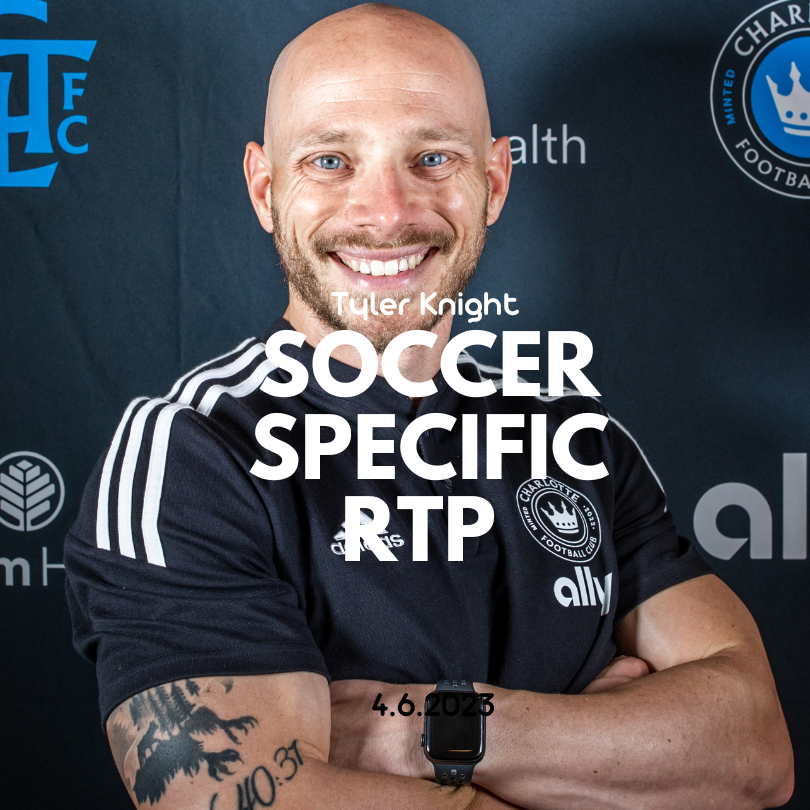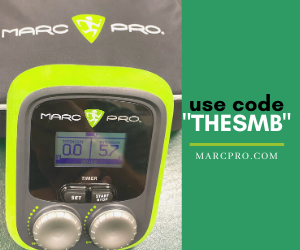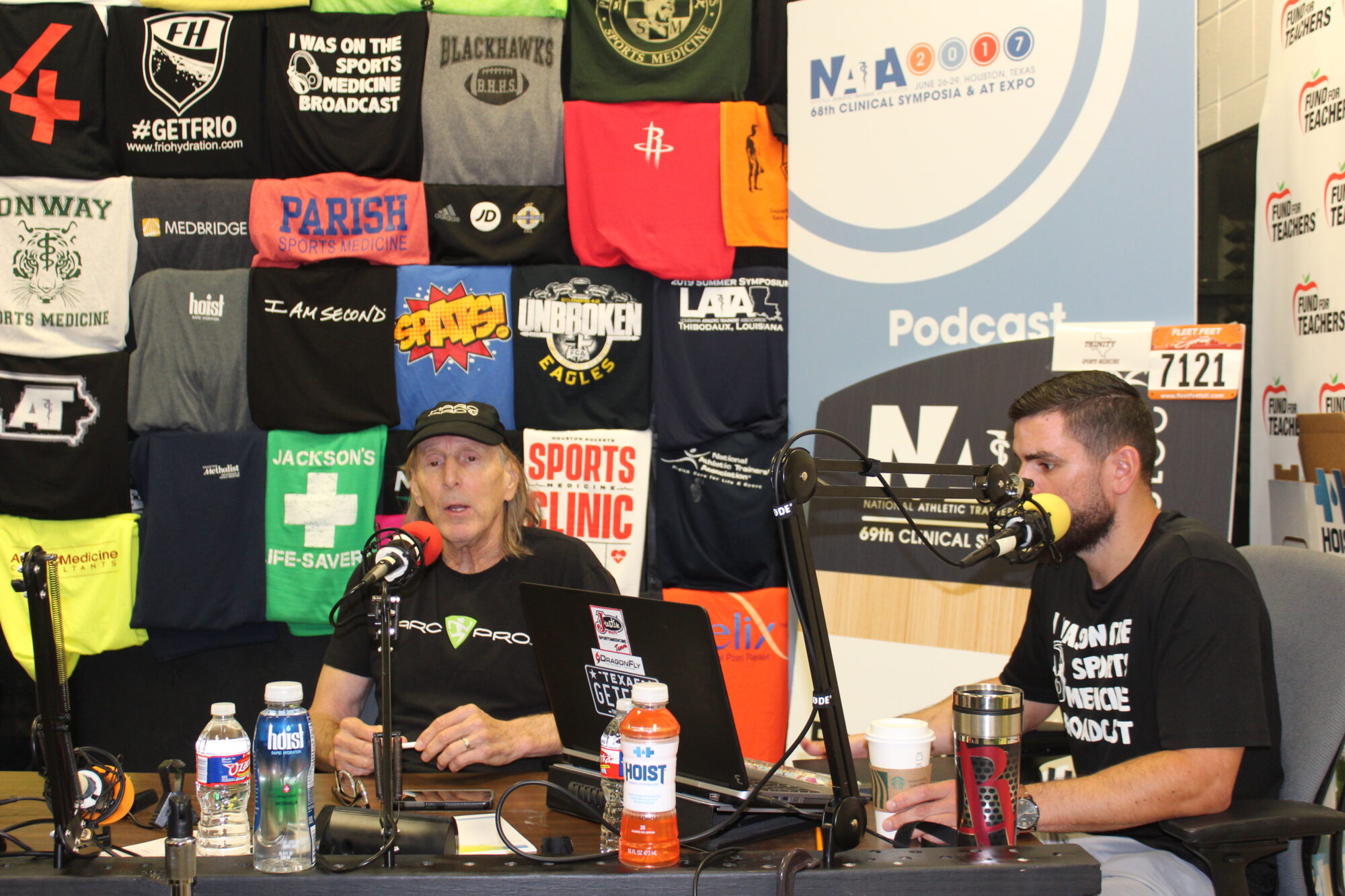Podcast: Play in new window | Download
Tyler Knight shares some Soccer Specific Return To Play or RTP tips and tricks. With nearly a decade of soccer experience, he has seen a lot of growth in sport-specific rehab plans.

What is the least soccer specific rehab exercise you have seen?
- Almost everything we do…discuss the importance of understanding the ‘why’ of what we do, as well as never forgetting components of movement.
- Isometrics because the patient can’t perform much more
- Eccentrics once able
- Stretch-shortening cycle
- Unloaded → supported → unsupported
“Train movement not muscles”
What do we need to consider in on-field RTP?
- In order to get to the field, you have to get out of the Athletic Training room first.
- Treat the person, not the athlete or the injury (reference all that people have going on in their lives). Ron Corson-ism
- Good communication, setting expectations, and appropriate planning are MUSTs.
- Individualization (based on person, position, and injury)
- Consider our two biggest protective capacities and build upon those early: strength and endurance
- Programming based upon working zones (importance of ESD)
- Quantifying internal vs. external load
- Individualization (based on person, position, and injury)
- To do that, we have a few basic rules at Charlotte FC:
1. Create a safe environment.
2. Don’t hurt the person.
3. Be aggressive without breaking rules 1 and 2.
- KPIs to provide direction and accountability to the process
- Additional principles of rehab to accelerate and enhance what we do on the field:
- Move early, move often.
- Highlight BFR and isometrics.
- Don’t mess it up.
- Consider tissue healing times.
- Periodize manual therapies, incorporate things the person believes in
- Break down the phases of healing (acute, subacute, remodeling), as well as the places of healing: table, Athletic Training room, gym, field, and everything in between.
- Create time for mental or psychological recovery
- Move early, move often.
- KPIs
- Mobility
- Stability
- Function
- Power
- On-Field
- Consider position, individual needs, team tactics, and demands of the sport…and MAKE IT FUN
- Players have the ball only 3% of the time, a good reason to emphasize the incorporation of the ball and fitness/drill exercises that place focus on getting into the right spaces
- In 2019/2020 EPL season, the highest average number of passes per game was 688 (Man City; approx 62. per player) and the least was Burnley at 333 (approx. 30 per player).
- Paul Bradley research
- Consider control – chaos continuum
- Reverse engineer and use the prospective loading document
- When we have elevated AC ratios, did the majority of that come from a more controlled environment or chaotic environment
- By using fatigue, you can increase chaos (for those athletes limited in what they can perform)
- How are you going to account for one of the most unique facts of the game: limited substitutions and, potentially like many other sports, the pace of the game is only increasing
- Actual loading
- Link load with the context of how it happens in a session/match
- TD, HSR, sprint, ACC/DEC, HMLD or explosive efforts
- Intensive vs. extensive days (can you match what the player is doing with you to what the team is doing; team schedule, RPExduration)
- Density of high intensity actions (repeated sprint ability and repeated high intensity efforts in 1, 3, and 5 min blocks)
- Consider position, individual needs, team tactics, and demands of the sport…and MAKE IT FUN
In the secondary setting, we may not be out on the field for practice. How can we help coordinate RTPs?
- “It takes a village.” Educate, incorporate, and empower those around you. If we all understand the why, we will know how to do it, and what we need to use to get there. Trust is a major factor here.
- Create a PowerPoint document, have illustrations, don’t be afraid to do the math ahead of time, use a stopwatch.
Let's talk through a RTP plan you use and why:
- The war is won and lost in the mind
- Briefly recap where we are and where we’re going
- What can we do to prepare, potentiate, desensitize, or address other movement qualities before we hit the pitch; build time and trust with people
- Individualization:
- Needs assessment to construct rehab or movement plan:
- Current injury
- Previous hx of injury
- Quality of movement (identify areas to fine-tune)
- Training history (gym)
- Movement and ability restoration
- Major proponent of push-pull movements or complex training (plyo-like), also appreciate avenues to incorporate lumbopelvic hip stability (core transferring F)
- External load
- Average weekly load in training
- Average match load
- These are BUDGETS, it’s science AND art
- If they aren’t close to being on the field, what are we going to do to reduce that gap (RPE x duration; off legs conditioning, gym, etc.)
- Needs assessment to construct rehab or movement plan:
- On-Field
- 4 levels
- 1: high control
- Band 1 ACC/DEC, no HSR/sprint
- 2: medium control
- Band 2 ACC/DEC, add HSR, no sprint
- 3: low control to low chaos
- Band 3 ACC/DEC; add sprint
- 4: medium to high chaos
- Add density to exposures
- 1: high control
- Drill selection
- Technical
- Tactical/passing
- Position specific
- **all interspersed with position specific running**
- MAS, ASR, or loading focused
- 4 levels
- How can we get players out of rehab the same care and joy others get from playing the game
- Revisit the plan often to show progress
- Change the setting
- Make it fun, do what you can with them
- Week
- Monday: introductory day
- Tuesday: small to medium space
- Wednesday: large space
- Thursday: treatment only
- Friday: small to medium space day, slightly more than re-intro
- Saturday: super-Saturday
- Sunday: OFF
Contact Us:
Tyler – tknightatc@gmail.com
Jeremy – @MrJeremyJackson
These people LOVE Athletic Trainers and help support the podcast:
Frio Hydration – Superior Hydration products.
Donate and get some swag (like Patreon but for the school)
HOIST – No matter your reason for dehydration DRINK HOIST
MedBridge Education – Use “TheSMB” to save some, be entered in a drawing for a second year free, and support the podcast.
Marc Pro – Use “THESMB” to recover better.

